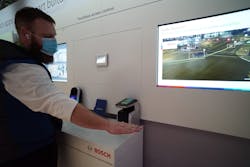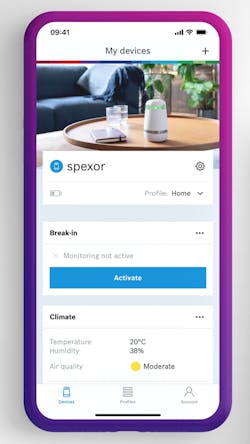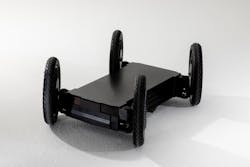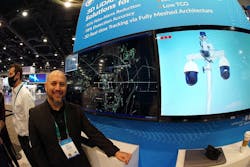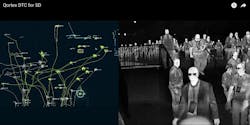The aisles are wider and there are fewer of the larger exhibitors, but there was no shortage of leap-forward technology leveraging artificial intelligence, using new robotics platforms and helping to identify potential threats. Health and safety solutions were also in abundance, adding to Covid-19 mitigation strategies with new autonomous vacuums and small office and bus air circulation systems claiming to kill the virus.
Here are few of the exhibitors I had a chance to catch up with on the first day of this year’s show:
Bosch
Bosch, like GM and other automotive technology platform solution providers at this year’s event, showed that present and future vehicles will look more like large electronic machinery than the mechanical vehicle mankind knew until a few years ago
Advanced Driving Module (ADM)
The latest Bosch ADM includes a generic drive, brake and steering package for electric vehicles (EVs), which is intended to reduce complexity in the development and engineering of EVs and increase efficiency for automakers.
Virtual Visor
At CES 2020, Bosch presented a virtual sun visor concept for drivers consisting of a very slim LED display, perfectly transparent, that reduces incision from sunlight and headlights of cars in the sight of the driver. At this year’s show, the ADM shares imagery from an advanced video camera with the virtual visor, detecting the position of the eyes, through machine learning, and darkens the pixels at their height to avoid glare. The view only in the areas where the light is coming from is darkened in real-time, keeping a completely clear view of the surrounding area.
Cars are not the only relevant EVs in the rapidly growing “Vehicle Intelligence & Transportation” sector; Bosch won a CES 2022 Innovation Award with their new eBike that your mobile security guard may use to enhance facility security.
AI shield
Cyberattack growth and differentiation are the “new normal” for today’s IoT devices in safety, security and sustainability solutions. AI, but more specifically Machine Learning through Deep Neural Networks (DNN) for cyber threat behavior and Convolutional Neural Networks (CNN) for image recognition are helping under-resourced Certified Information Systems Security Officers (CISSO) stay ahead of threats. DNNs and CNNs provide rapid recognition to cut through the noise of daily alerts, drastically reducing cyberattack response times. For Bosch, AI shield is a breakthrough security product featuring these tools as real-time protection through vulnerability analysis and behavioral learning about the actual attacks taking place, supplementing “off-the-shelf” cyber libraries and playbooks.
The SaaS (software as a service) tool and user interface allow developers to scale, protecting intellectual property (IP), brands, investments, and ultimately, trust in digitalization, part of Bosch’s evolving AI Code of Ethics.
Azena
Developed by the Bosch subsidiary Azena, the security industry’s practitioner and integrator-facing App Store has more than 100 video analytic apps for detecting face masks, smoke, fire, and flooding or for flow of traffic and visitors. Strong development trends include machine learning apps that complement touchless access control, match a “smart space’s” occupancy to their required building functions and real-time traffic management.
Spexor
Bosch’s small business, home or mobile security assistant is an intelligent all-in-one appliance detecting break-ins and hazardous gases, room-air quality changes, and temperature timist. Spexor looks for anomalies in the monitored environment and sends notifications to mobile devices.
Hyundai Mobility
Called the Mobile Eccentric Droid (MobED), Hyundai has brought a high-tech robotic, locomotive platform that can maneuver around and over obstacles in all sorts of environments with a top speed of 18 mph, similar to an electric scooter. At 26 inches in length and 23 inches wide, with four-wheel independent suspension and ‘Eccentric Wheel’ drive, the 100-pound MobED maintains stability even if it’s on an incline or uneven roads.
Hyundai has created a platform of PnD (Plug & Drive) robotics under the new concept “Mobility of Things” (MOT), which aims to provide mobility to any element, like surveillance and occupancy sensors or Covid-19 cleaning devices in public spaces.
In July, we reported on Ghost Robotics incredibly agile “Q-UGV Dog,” at ISC West 2021, that currently is being used at nuclear waste disposal sites and in other markets requiring extraordinary safety measures. Just as Ghost Robotics originated from University of Pennsylvania’s Pennovation Lab, Boston Dynamics, founded in 1992, came out of the MIT Leg Lab. In July. Hyundai Motor Group acquired controlling interest in Boston Dynamics valued at $1.1 billion, clearly signaling its intention to become a global robotic solutions provider.
Quanergy
3D LiDAR
Two dimensional LiDAR, which stands for Light Detection and Ranging, is a time-of-flight sensing technology that pulses low-power, eye-safe lasers and measures the time it takes for the laser to complete a round trip between the sensor and a target. The LiDAR “curtain” of emitters has to move side-to-side or just simply spin rapidly to distribute these pulses that, once received, measure and create a point cloud of an object or environment to be created continuously in real-time.
So how can we improve on these devices that already reduce costs and complement surveillance cameras for space protection and object classification? The MQ-8 Series 3D LiDAR sensor features a smart beam structure of narrowly spaced, asymmetric beams, with each sensor capable of 15,000 square meters of coverage, 100-times wider than camera-based systems. Pair the MQ-8 with QORTEX DTC, and this solution detects, tracks and classifies up to 250 objects at 10% reflectivity and up to a range of 70 meters (140-meter diameter) with 95% accuracy. Quanergy’s 3D AI-powered LiDAR Flow Management platform is aimed at increasing efficiency in response to security breaches and drastically reducing costly false alarms.
IP surveillance cameras have relatively short detection ranges and most also require third-party software to handover to another camera. Privacy masking is also often needed to protect faces, license plates and other personally identifiable information (PII) in specific public spaces where there is an expectation of privacy. However, the 3D LiDAR sensors and QORTEX platform have long detection ranges, automatically work with multiple LiDAR sensors and integrate with popular video management systems. And because point clouds are formed, no PII is recorded, preserving privacy.
The user experience (UX) with QORTEX is so advanced that the security operator can view hundreds of objects (people or vehicles) moving in and around restricted and permitted areas in a plan view on a screen, then turned on its edge so the object heights may be seen, and horizontal motion viewed.
The rich object data generated by the QORTEX perception software can be used to automate critical security processes to protect sensitive environments including government and enterprise buildings, airports, critical infrastructure, national borders, historic landmarks, and more. The solution’s Automated ID Handover capability allows continuous tracking of up to 300 individuals or vehicles through restricted and permitted areas throughout the system’s entire field of view.
This makes curb-to-gate people tracking at airports, and social distancing applications in public venues like stadiums possible.
Solid State LiDAR
The S3-2 Solid State LiDAR module (eye safe IEC 60825-1) is ultra-small (emitter is about a half inch square), has no moving parts, but can be commanded to direct a beam instantaneously in three dimensions, making this a breakthrough product where long mean time between failures (MTBF) is required, such as with AVs, autonomous EVs, OEM entry access control systems, and transportation and industrial controls.
The Solid State LiDAR Sensor is 100% CMOS, and the patented Optical Phased Array (OPA) electronic beam steering has achieved a long range performance of 200 meters in bright sunlight, and is designed to achieve low cost and large-scale commercial deployment in the automotive and industrial markets. The OPA technology is similar in nature to Phase Array technology used in radar where it is shipped in over 20 million units annually.
About the Author:
Steve Surfaro is Chairman of the Public Safety Working Group for the Security Industry Association (SIA) and has more than 30 years of security industry experience. He is a subject matter expert in smart cities and buildings, cybersecurity, forensic video, data science, command center design and first responder technologies. Follow him on Twitter, @stevesurf.
